Sculptures
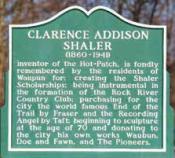
A TIMELESS LEGACY
Clarence Shaler was a successful Waupun industrialist who was born the son of Mackford Prairie farmers. Shaler was an inventive genius who was always looking for better ways to do things. Perhaps that’s why he fostered such a love for sculpture, a kind of art that lends itself well to interpretation from a multitude of perspectives. Not only was Shaler instrumental in bringing two major works of American art to Waupun but also, he began sculpting his own heritage in bronze at age 70, further expressing a lifelong love of art. One by one, he donated pieces to the City of Waupun and other institutions with which he felt a personal connection.
Today Waupun has one of the highest concentrations of public art per capita in the United States, thanks to one remarkable pioneer and the rich cultural inheritance he left behind. The City of Sculpture proudly displays this timeless legacy for your viewing pleasure.
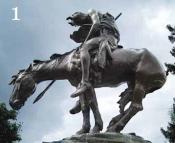
THE END OF THE TRAIL
The image of this heroic bronze, even its silhouette, has become an icon representing the plight of Native Americans who were displaced across this country.
The original model of “The End of the Trail” was created by James Earl Fraser in 1894 when he was 17 years old. Its completed size was only 18 inches tall. Fraser replicated his masterpiece in plaster for the 1914 Panama Pacific International Exposition in San Francisco which was where Shaler first beheld the work of art. The child of pioneer farmers, Shaler witnessed the plight of Native Americans and was saddened by their disappearance. As a tribute, he commissioned James Earl Fraser to cast the statue in bronze at a cost of $50,000 and gifted it to the City of Waupun. The sculpture was unveiled at its present site on June 23, 1929. In 1975, the statue became a Wisconsin landmark and is listed on the National Register of Historic Sites.
LOCATION: Shaler Park, 400 N. Madison Street
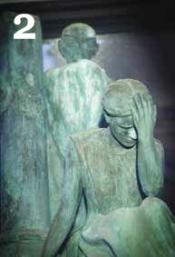
THE CITADEL
Called one of Shaler’s masterpieces by a noted art conservator, The Citadel is one of the most recent additions to Waupun’s bronze gallery.
Shaler usually sculpted life-size tributes to his pioneer roots in bronze, covered in dark brown patinas. The dark theme of this piece, its unnerving devil and desperate woman, coupled with a mint-green patina make it a dramatic departure from Shaler’s usual style. Family members say Shaler may have been depicting the cataclysmic events taking place in Nazi Germany during World War II, sculpting the devil to represent the Nazi Party and the downcast woman, the German people. The Citadel was displayed at the University of Southern California in 1942 and was donated to the City of Waupun in the fall of 1994.
LOCATION: In front of Waupun Heritage Museum, 22 S. Madison Street
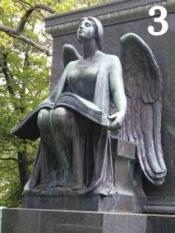
RECORDING ANGEL
Shaler commissioned this serene angel in honor of his beloved wife, Blanche Bancroft Shaler, after her death. Recording Angel is the work of Lorado Taft, one of America’s foremost sculptors.
Shaler was conducting business in Chicago when he wandered into Taft’s studio. As their friendship developed, Taft became influential to Shaler’s growing interest in the art of sculpture. The detail on this statue is exquisite, from the filaments on the angel’s wings to her detailed toes. Recording Angel was presented as a gift to Waupun in 1923 and is now listed on the National Register of Historic Sites.
LOCATION: Central part of Forest Mound Cemetery on N. Madison Street
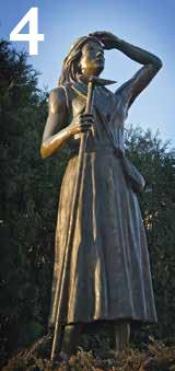
WHO SOWS BELIEVES IN GOD
A monument to the optimism of those who plant all kinds of seeds, Who Sows is one of Clarence Shaler’s later works.
This statue spent 30 years in a basement after University of Wisconsin professors labeled it “inferior art.” For another 15 years it was placed in an isolated spot overlooking the fields of University Farms near Arlington, Wisconsin. Waupun historians recognized the value of the piece and petitioned to bring it to the City of Waupun where it was dedicated in August of 1995.
LOCATION: Waupun Memorial Hospital, 620 W. Brown Street
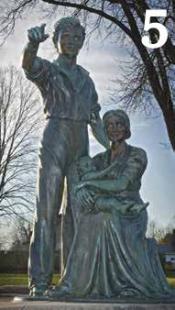
THE PIONEERS
Shaler created this young family out of respect for the optimism that helped his parents and other settlers to forge ahead in the untamed wilderness of America.
Since its dedication in 1940, The Pioneers has been a well-loved landmark at Waupun’s Wilcox Park. Shaler sculpted this piece in memory of his mother’s steadfast dedication to her family and the toilsome pioneer lifestyle.
LOCATION: Wilcox Park, 404 S. Watertown Street
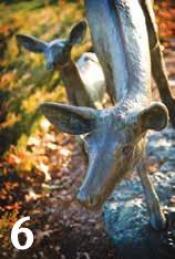
DOE AND FAWN
This pair of deer are Shaler’s simple tribute to the pastoral scene at the Rock River Country Club, one of his favorite places. Wildlife roamed the grounds then as they do today.
In addition to inventing and manufacturing a new kind of umbrella, Shaler’s company also produced golf clubs. The wise industrialist was instrumental in creating Waupun’s Rock River Country Club.
LOCATION: Rock River Country Club entrance, 700 County Park Road

MORNING OF LIFE
Shaler created this sculpture – some say his finest – in memory of his twin sister, Clara, who died at age 18 in the morning of her life. The bronze statue, a life-size young girl seated on a large rock, eyes gazing heavenward, stands in the quiet of Union Cemetery in Mackford Prairie, twelve miles northwest of Waupun.
LOCATION: Highway 49N (Main St., Waupun) to County Trunk AW; 6 ½ miles west to County Trunk Q; 3 miles north on Q to County Trunk X; ½ mile west on X to Union Cemetery
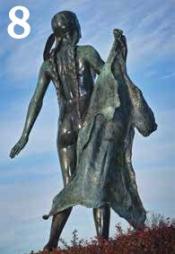
DAWN OF DAY
“…like this Indian maiden who is casting off the old garments…who will ever look forward to the dawn of day of greater prosperity and happiness,” Shaler said in his dedication speech.
This statue, dedicated in 1931, is also known as “Waubun,” a Native American word which means “dawn of day.” The City of Waupun was originally called Waubun. The ‘b’ became a ‘p’ when the city’s name was commissioned around 1840 and a spelling error was made. Dawn of Day was Shaler’s first heroic bronze statue, sculpted using several different models to achieve the maiden’s perfection.
LOCATION: City Hall, 201 E. Main Street

